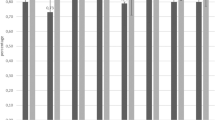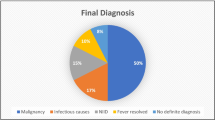Abstract
Objective
To assess the influence of clinical features and laboratory test results on the determination of fever of unknown origin (FUO) by means of 18F-FDG PET/CT.
Methods
Retrospective and longitudinal analysis, including all the PET/CT studies requested for FUO. Reference standard was established by serology, cultures or biopsy with other laboratory tests or clinical follow-up when necessary. Clinical variables, inflammation markers, protein analysis, serology and culture results close to the PET scan were obtained. The final diagnosis was classified into three groups attending to the etiology; group 1: infection or neoplasm, group 2: vasculitis, autoimmune disease or non-infectious inflammatory disease and group 3: auto-limited fever or persistent fever without diagnosis. PET/CT scans were classified as positive or negative and helpful or not in the diagnosis of the fever origin. The effect of clinical features and laboratory variables on the PET/CT results was analyzed.
Results
Sixty-seven patients were evaluated. The final diagnosis was: Group 1 (25), Group 2 (20) and Group 3 (22). 89.6% of patients had a positive inflammation marker, 28.4% proteinogram alterations and 20.9% positive cultures. PET/CT was positive in 52/67 patients. PET/CT helped in the establishment of the fever origin in 35 cases and was especially helpful in groups 1 and 2. Sensitivity, specificity and accuracy of PET/CT were: 84, 31 and 61%. PET results shown significant relations with the final diagnosis (p = 0.035) and culture results (p = 0.037). No significant relations were observed with the rest of clinical or laboratory variables.
Conclusions
18F-FDG PET/CT had a high sensitivity but a low specificity in the diagnosis of the fever origin, probably due to the high rate of diffuse and auto-limited aetiologies. Patients who are most likely to benefit from the PET/CT study would be those with several positive inflammation markers, reflecting a higher pre-test probability of active disease.


Similar content being viewed by others
References
Mourad O, Palda V, Detsky AS. A comprehensive evidence-based approach to fever of unknown origin. Arch Intern Med. 2003;163:545–51.
Dong MJ, Zhao K, Liu ZF, Wang GL, Yang SY, Zhou GJ. A meta-analysis of the value of fluorodeoxyglucose-PET/PET-CT in the evaluation of fever of unknown origin. Eur J Radiol. 2011;80:834–44.
de Kleijn EM, van Lier HJ, van der Meer JW. Fever of unknown origin (FUO). II. Diagnostic procedures in a prospective multicenter study of 167 patients. The Netherlands FUO Study Group. Medicine (Baltimore). 1997;76:401–14.
Vanderschueren S, Knockaert D, Adriaenssens T, Demey W, Durnez A, Blockmans D, et al. From prolonged febrile illness to fever of unknown origin: the challenge continues. Arch Intern Med. 2003;163:1033–41.
Besson FL, Chaumet-Riffaud P, Playe M, Noel N, Lambotte O, Goujard C, et al. Contribution of 18F-FDG PET in the diagnostic assessment of fever of unknown origin (FUO): a stratification-based meta-analysis. Eur J Nucl Med Mol Imag. 2016;43:1887–95.
Becerra Nakayo M, García Vicente AM, Soriano Castrejón A, Mendoza Narváez JA, Talavera Rubio MP, Poblete García VM, et al. Analysis of cost-effectiveness in the diagnosis of fever of unknown origin and the role of (18)F-FDG PET-CT: a proposal of diagnostic algorithm. Rev Esp Med Nucl. 2012;31:178–86.
Qiu L, Chen Y. The role of 18F-FDG PET or PET/CT in the detection of fever of unknown origin. Eur J Radiol. 2012;81:3524–9.
Crouzet J, Boudousq V, Lechiche C, Pouget JP, Kotzki PO, Collombier L, et al. Place of (18)F-FDG-PET with computed tomography in the diagnostic algorithm of patients with fever of unknown origin. Eur J Clin Microbiol Infect Dis. 2012;31:1727–33.
Durak DT, Street AC. Fever of unknown origin—re-examined and refined. Curr Clin Top Inf Dis. 1991;11:35–51.
Malide D, Davies-Hill TM, Levine M, Simpson IA. Distinct localization of GLUT-1 and—5 in human monocyte-derived macrophages: effects of cell activation. Am J Physiol. 1998;274:E516–E526.
Webb M, Chambers A, Al-Nahhas A, Mason JC, Maudlin L, Rahman L, et al. The role of F-18-FDG-PET in characterising disease activity in Takayasu arteritis. Eur J Nucl Med Mol Imaging. 2004;31:627–34.
Blockmans D, de Ceuninck L, Vanderschueren S, Knockaert D, Mortelmans L, Bobbaers H. Repetitive 18F-fluorodeoxyglucose positron emission tomography in giant cell arteritis: a prospective study of 35 patients. Arthritis Rheum. 2006;55:131–7.
Seshadri N, Sonoda LI, Lever AM, Balan K. Superiority of 18F-FDG PET compared to 111In-labelled leucocyte scintigraphy in the evaluation of fever of unknown origin. J Infect. 2012;65:71–9.
Buysschaert I, Vanderschueren S, Blockmans D, Mortelmans L, Knockaert D. Contribution of (18)fluoro-deoxyglucose positron emission tomography to the work-up of patients with fever of unknown origin. Eur J Intern Med. 2004;15:151–6.
Tokmak H, Ergonul O, Demirkol O, Cetiner M, Ferhanoglu B. Diagnostic contribution of (18)F-FDG-PET/CT in fever of unknown origin. Int J Infect Dis. 2014;19:53–8.
Bleeker-Rovers CP, Vos Fidel J, Mudde Aart H, Dofferhoff Anton SM, de Geus-Oei L-F, Rijnders Anton J. A prospective multi-centre study of the value of FDG-PET as part of a structured diagnostic protocol in patients with fever of unknown origin. Eur J Nucl Med Mol Imag. 2007;34:694–703.
Pereira A, Husmann L, Sah B-R, Battegay E, Franzen D. Determinants of diagnostic performance of 18F-FDG PET/CT in patients with fever of unknown origin. Nucl Med Commun. 2016;37:57–65.
Knockaert DC, Vanderschueren S, Blockmans D. Fever of unknown origin in adults: 40 years on. J Intern Med 2003;253:263–75.
Gaeta GB, Fusco FM, Nardiello S. Fever of unknown origin: a systematic review of the literature for 1995–2004. Nucl Med Commun 2006;27:205–11.
De Groot M, Meeuwis AP, Kok PJ, Corstens FH, Oyen WJ. Influence of blood glucose level, age and fasting period on non-pathological FDG uptake in heart and gut. Eur J Nucl Med Mol Imaging. 2005;32:98–101.
Kubota K, Nakamoto Y, Tamaki N, et al. FDG-PET for the diagnosis of fever of unknown origin: a Japanese multi-center study. Ann Nucl Med. 2011;25:355–64.
Meller J, Sahlmann C-O, Scheel A-K. 18F-FDG PET and PET/CT in fever of unknown origin. J Nucl Med. 2007;48:35–45.
Kouijzer IJ, Bleeker-Rovers CP, Oyen WJ. FDG-PET in fever of unknown origin. Semin Nucl Med. 2013;43:333–9.
Pelosi E, Skanjeti A, Penna D, Arena V. Role of integrated PET/CT with [18F]-FDG in the management of patients with fever of unknown origin: a single-centre experience. Radiol Med. 2011;116:809–20.
Manohar K, Mittal BR, Jain S, Sharma A, Kalra N, Bhattacharya A, et al. F-18 FDG-PET/CT in evaluation of patients with fever of unknown origin Jpn. J Radiol. 2013;31:320–7.
Kjaer A, Lebech AM, Eigtved A, Hojgaard A. Fever of unknown origin: prospective comparison of diagnostic value of 18F-FDG PET and 111 In-granulocyte scintigraphy. Eur J Nucl Med Mol Imaging. 2004;31:622–6.
Federici L, Blondet C, Imperiale A, Sibilia J, Pasquali JL, Pflumio F, et al. Value of (18)F-FDG-PET/CT in patients with fever of unknown origin and unexplained prolonged inflammatory syndrome: a single centre analysis experience. Int J Clin Pract. 2010;64:55–60.
Keidar Z, Gurman-Balbir A, Gaitini D, Israel O. Fever of unknown origin: the role of 18F-FDG PET/CT. J Nucl Med. 2008;49:1980–5.
Balink H, Collins J, Bruyn GA, Gemmel F. F-18 FDG PET/CT in the diagnosis of fever of unknown origin. Clin Nucl Med. 2009;34:862–8.
Kim YJ, Kim SI, Hong KW, Kang MW. Diagnostic value of (18)F-FDG PET/ CT in patients with fever of unknown origin. Intern Med J. 2012;42:834–37.
Lorenzen J, Buchert R, Bohuslavizki KH. Value of FDG-PET in patients with fever of unknown origin. Nucl Med Commun. 2001;22:779–83.
Bleeker-Rovers CP, de Kleijn E, Corstens FHM, van der Meer JW, Oyen WJ. Clinical value of FDG-PET in patients with fever of unknown origin and patients suspected of focal infection or inflammation. Eur J Nucl Med Mol Imaging. 2004;31:29–37.
Jaruskova M, Belohlavek O. Role of FDG-PET and PET/CT in the diagnosis of prolonged febrile states. Eur J Nucl Med Mol Imaging. 2006;33:913 – 18.
Blockmans D, Knockaert D, Maes A, De Caestecker J, Stroobants S, Bobbaers H, et al. Clinical value of [F-18]fluorodeoxyglucose positron emission tomography for patients with fever of unknown origin. Clin Infect Dis. 2001;32:191–6.
Mulders-Manders C, Simon A, Bleeker-Rovers C. Fever of unknown origin. Clin Med 2015;15:280–84.
Gafter-Gvili A, Raibman S, Grossman A, Avni T, Paul M, Leibovici L, et al. [18F]FDG-PET/CT for the diagnosis of patients with fever of unknown origin. Q J Med. 2015;108:289–98.
Funding
No funding has been received.
Author information
Authors and Affiliations
Corresponding author
Ethics declarations
Conflict of interest
The authors have no conflict of interest.
Ethical standards
All the procedures performed in studies involving human participants were in accordance with the ethical standards of the institutional and/or national research committee and with the 1964 Helsinki declaration and its later amendments or comparable ethical standards.
Informed consent
Informed consent was obtained from all the individual participants included in the study.
Rights and permissions
About this article
Cite this article
García-Vicente, A.M., Tello-Galán, M.J., Amo-Salas, M. et al. Do clinical and laboratory variables have any impact on the diagnostic performance of 18F-FDG PET/CT in patients with fever of unknown origin?. Ann Nucl Med 32, 123–131 (2018). https://doi.org/10.1007/s12149-017-1226-8
Received:
Accepted:
Published:
Issue Date:
DOI: https://doi.org/10.1007/s12149-017-1226-8




